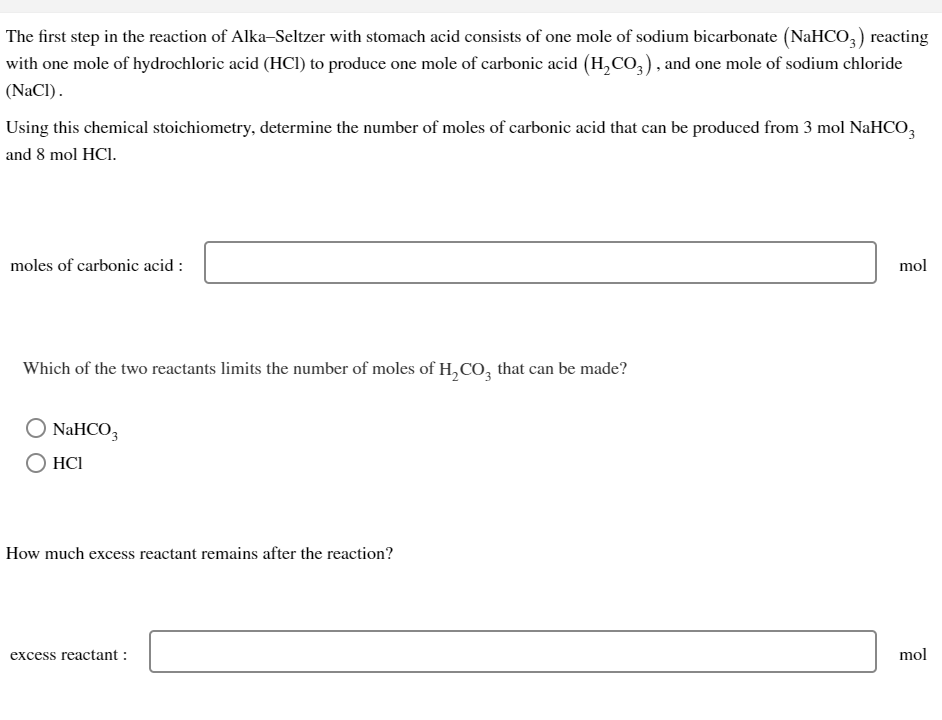The first step in the reaction of Alka-Seltzer with stomach acid consists of one mole of sodium bicarbonate (NaHCO3) reacting with one mole of hydrochloric acid (HCI) to produce one mole of carbonic acid (H₂CO3), and one mole of sodium chloride (NaCl). Using this chemical stoichiometry, determine the number of moles of carbonic acid that can be produced from 3 mol NaHCO3 and 8 mol HCI. moles of carbonic acid : Which of the two reactants limits the number of moles of H₂CO3 that can be made? NaHCO3 HCI How much excess reactant remains after the reaction? excess reactant : mol mol
The first step in the reaction of Alka-Seltzer with stomach acid consists of one mole of sodium bicarbonate (NaHCO3) reacting with one mole of hydrochloric acid (HCI) to produce one mole of carbonic acid (H₂CO3), and one mole of sodium chloride (NaCl). Using this chemical stoichiometry, determine the number of moles of carbonic acid that can be produced from 3 mol NaHCO3 and 8 mol HCI. moles of carbonic acid : Which of the two reactants limits the number of moles of H₂CO3 that can be made? NaHCO3 HCI How much excess reactant remains after the reaction? excess reactant : mol mol
Introduction to Chemical Engineering Thermodynamics
8th Edition
ISBN:9781259696527
Author:J.M. Smith Termodinamica en ingenieria quimica, Hendrick C Van Ness, Michael Abbott, Mark Swihart
Publisher:J.M. Smith Termodinamica en ingenieria quimica, Hendrick C Van Ness, Michael Abbott, Mark Swihart
Chapter1: Introduction
Section: Chapter Questions
Problem 1.1P
Related questions
Question
check the image for question

Transcribed Image Text:The first step in the reaction of Alka-Seltzer with stomach acid consists of one mole of sodium bicarbonate (NaHCO3) reacting
with one mole of hydrochloric acid (HCI) to produce one mole of carbonic acid (H₂CO3), and one mole of sodium chloride
(NaCl).
Using this chemical stoichiometry, determine the number of moles of carbonic acid that can be produced from 3 mol NaHCO3
and 8 mol HCI.
moles of carbonic acid:
Which of the two reactants limits the number of moles of H₂CO3 that can be made?
O NaHCO3
HC1
How much excess reactant remains after the reaction?
excess reactant:
mol
mol
Expert Solution
This question has been solved!
Explore an expertly crafted, step-by-step solution for a thorough understanding of key concepts.
This is a popular solution!
Trending now
This is a popular solution!
Step by step
Solved in 4 steps

Recommended textbooks for you

Introduction to Chemical Engineering Thermodynami…
Chemical Engineering
ISBN:
9781259696527
Author:
J.M. Smith Termodinamica en ingenieria quimica, Hendrick C Van Ness, Michael Abbott, Mark Swihart
Publisher:
McGraw-Hill Education

Elementary Principles of Chemical Processes, Bind…
Chemical Engineering
ISBN:
9781118431221
Author:
Richard M. Felder, Ronald W. Rousseau, Lisa G. Bullard
Publisher:
WILEY

Elements of Chemical Reaction Engineering (5th Ed…
Chemical Engineering
ISBN:
9780133887518
Author:
H. Scott Fogler
Publisher:
Prentice Hall

Introduction to Chemical Engineering Thermodynami…
Chemical Engineering
ISBN:
9781259696527
Author:
J.M. Smith Termodinamica en ingenieria quimica, Hendrick C Van Ness, Michael Abbott, Mark Swihart
Publisher:
McGraw-Hill Education

Elementary Principles of Chemical Processes, Bind…
Chemical Engineering
ISBN:
9781118431221
Author:
Richard M. Felder, Ronald W. Rousseau, Lisa G. Bullard
Publisher:
WILEY

Elements of Chemical Reaction Engineering (5th Ed…
Chemical Engineering
ISBN:
9780133887518
Author:
H. Scott Fogler
Publisher:
Prentice Hall


Industrial Plastics: Theory and Applications
Chemical Engineering
ISBN:
9781285061238
Author:
Lokensgard, Erik
Publisher:
Delmar Cengage Learning

Unit Operations of Chemical Engineering
Chemical Engineering
ISBN:
9780072848236
Author:
Warren McCabe, Julian C. Smith, Peter Harriott
Publisher:
McGraw-Hill Companies, The